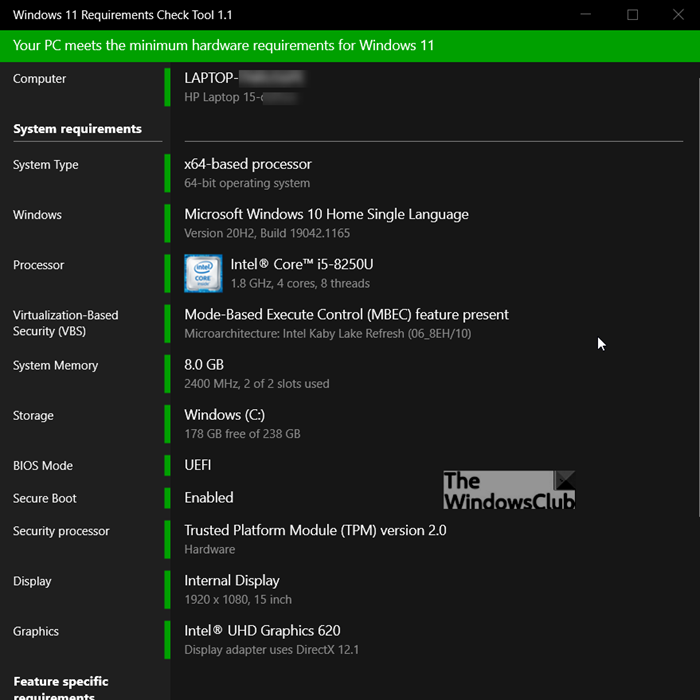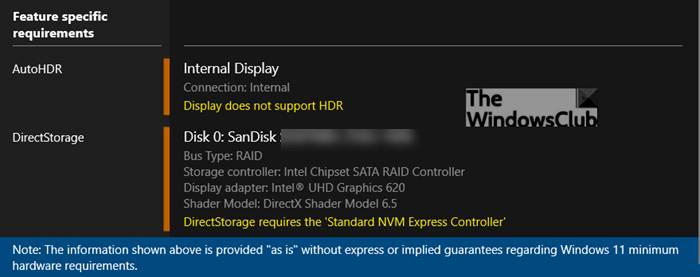If you want to find if your device qualifies for the upcoming Windows 11 update or not, use Windows 11 Requirements Checker Tool to discover it. The tool runs a test to check if your PC meets the system requirements to run Windows 11. In addition, it checks if your PC can support (gaming) features like AutoHDR and DirectStorage.
Windows 11 Requirements Checker Tool
Microsoft will check if your system can run Windows 11 by meeting certain minimum hardware requirements. These requirements, it feels, are necessary to boot and run Windows 11, update and service your system, and provide a baseline user experience comparable with similar devices. Windows 11 Requirements Check Tool checks if the minimum hardware requirements for types of devices designed for Windows 11 are met by looking for the following configurations.
- BIOS Mode
- Display
- Graphics
- Processor
- Secure Boot
- Security Processor
- Storage
- System Memory
- Virtualization-Based Security (VBS)
- Windows version.
Is Windows 11 compatible with all PCs?
Windows 11 will not run on all PCs that run Windows 10 – It will run on most, but not all. There are some additional hardware requirements for the computer to be able to successfully run Windows 11 OS. PCs that do not meet the hard floor cannot be upgraded to Windows 11. PCs that meet the soft floor will receive a notification that an upgrade is not advised.
Windows 11 Requirements Checker Tool

The summary of the components provided under a single-window of Windows 11 Requirements Check Tool provides a snapshot of the minimum hardware requirements for Windows 11 and whether your system meets them all. simply download and run the application.
If prompted by a warning, click the More Info link and hit the Run Anyway button.
BIOS Mode
It shows whether your PC uses UEFI or legacy firmware. For instance, the entry is displayed in red if your PC uses legacy firmware to boot the computer.
Display
Checks if the size of your display meets the minimum requirement of 9” and supports a resolution of 720p or higher by gathering information from Extended Display Identification Data (EDID)
Graphics
Verifies if your display adapter (graphics card) supports DirectX 12 and WDDM 2.0 or not by collecting information from currently installed drivers.
Processor
The freeware utility examines if the processor in your system has at least 2 cores and running at a speed of 1 GHz or higher. In addition, it checks for other features.
Secure Boot
It displays 3 color bands namely, Red, orange, and green. Red indicates your system disk is formatted as MBR and therefore, incapable of using Secure Boot. Orange color means your system is capable of supporting Secure Boot. The green color means Secure Boot is enabled.
Security Processor
This checking module checks if the PC has a Trusted Platform Module (TPM) enabled or not. TPM is a chip that adds hardware-based security benefits to Windows. Besides, it also works as a secure crypto-processor to help with some of the tasks pertaining to actions like generating, storing, and limiting the use of cryptographic keys.
Storage
This heading in the freeware tool displays the capacity of the system volume. The item turns red if the capacity is less than 64GB.
System Memory
Determines the amount of physical memory dedicated to your PC and flags it (show in red) if the amount is less than 4GB.
Virtualization-Based Security (VBS)
Processors that support HVCI in hardware provide significant performance improvements. As such, the VBS parameter in this check tool checks if your processor has hardware support for Hypervisor-Enforced Code Integrity (HVCI) technology or not. Apart from this, VBS safeguards Windows from compromise by bad drivers and malicious system files.
Windows
This final check determines if the existing version of Windows you are running can be upgraded to Windows 11 or not.
In addition to running the components check, the freeware utility performs the following Windows 11 feature checks. Each of these checks is shown orange if your system does not support the feature.

- AutoHDR – Windows 11 has introduced AutoHDR. It adds HDR to games that do not support HDR, thereby improving graphics quality and immersive feeling. The freeware runs a test to determine if any of your currently connected displays support High Dynamic Range (HDR) content.
- DirectStorage – This is a feature that allows games to load quickly by working to load assets on the GPU. The tool is designed to check if the Storage Controller of your system disk and the Shader Model of your graphics card (GPU) meet DirectStorage requirements. If yes, it uses the discrete GPU for the validation.
You can download Windows 11 Requirements Check Tool from bytejams.com.
Other similar Windows 11 compatibility checker tools that may interest you are – PC Health Check Tool | WhyNotWin11 | Checkit | Windows 11 Compatibility Check Tool.
Hope it helps!